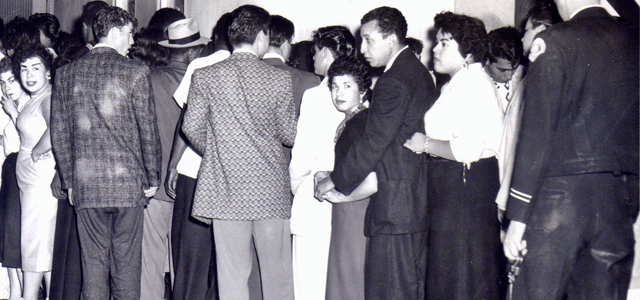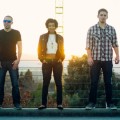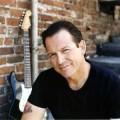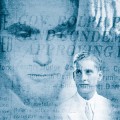As a teenager, when I snuck into a botched King Diamond show in the same building where the Fats Domino riot happened, I was too young to care about history.
With all the current yakking about plaques, landmarks, local music roots and such, one marker already exists, on the side of the Axis condo tower in downtown San Jose—a colorful reminder of the old Palomar Ballroom. Not enough people look at it, so I floated by the other day to reacquaint myself with the ghosts.
Several heroic folks have retroactively detailed the riot that unfolded at the Palomar Ballroom on the night of July 7, 1956. The late San Jose State history professor Larry Engelmann was probably the most enthusiastic. His 1996 story marked the 40th anniversary of the riot and his blog still remains online, replete with comments from people who attended the concert. Another endeavor, the nonprofit startup San Jose Rocks, founded by Dan Orloff, is similarly preserving historical rock roots in Silicon Valley, including any riot memories.
Located at 47 Notre Dame Ave, the Palomar Ballroom opened in 1947, attracting big bands, vocalists and jazz acts from far and wide. Then rock ’n’ roll happened.
The now-legendary Fats Domino gig was marred from the beginning because he arrived very late, too many people showed up, and hundreds were stuck outside. When the band finally played, many patrons were already drunk and unruly. Soon enough, during the intermission, beer bottles were thrown and a melee erupted. Multiple fisticuffs ensued. Chairs were smashed, glass was shattered and many were injured. Several people climbed out of windows to escape. Nearly a dozen attendees were arrested and much of the club was destroyed.
Fats Domino was not responsible for the violence, nor was rock music, but genteel daily newspapers from coast to coast wrote sensational headlines. A brand-new phrase, “Rock ’n’ Roll Riot,” took hold across the country. Remember, this was 1956.
The Palomar legacy was never limited to rock music, of course. In its original era, the Palomar was San Jose’s first racially integrated dance venue. And especially in a later incarnation as the Starlight Ballroom, it was an important venue for Latin music and events, deeply resonating with Mexican-American and Spanish-speaking communities. In the ’80s and ’90s, the same building morphed into popular nightclubs like Studio 47 and the Tropicana, further cementing its place in a continuum that hit home with diasporas of all sorts. As a brand, Studio 47 still carries weight.
My favorite memory of that building is of a canceled King Diamond show 35 years ago. The legendary Danish heavy metal singer with an operatic voice, face paint and theatrical Satanic panache was originally scheduled to play at the Flint Center, but the local promoters botched the entire thing. After absurd dimensions of finagling, the gig somehow wound up at Studio 47 instead.
Along with a few of my friends, we knew someone that knew someone, so we wound up getting inside to work briefly as “stagehands.” Yet it was still a disaster. King’s tour crew were seasoned European professionals, experienced roadies and managers, while the local promoters didn’t have it together. The sound system was garage-level junk, an embarrassment, so King Diamond’s entourage eventually just gave up and left, even though the crowd outside had already lined up for a long time.
Our teenage selves then later partied with King’s road crew in their RV, after they had parked at the Best Western on South First Street, which is now the Pacific Motor Inn. At the end of the night, I actually stood right next to King Diamond in that parking lot. He wasn’t wearing his makeup and he had a can of Budweiser in his hand.
So, if anything, I can declare that I drank beer with King Diamond after a botched gig in the same building as the Fats Domino riot. Only in downtown San Jose could I make such a claim. Only in San Jose would anyone else even care.
You don’t have to be an old fart to appreciate music from decades past. Go sneak into a Satanic metal show and see what happens. You might become a part of history.

 An Odd Space
An Odd Space  Sin Tax
Sin Tax 


